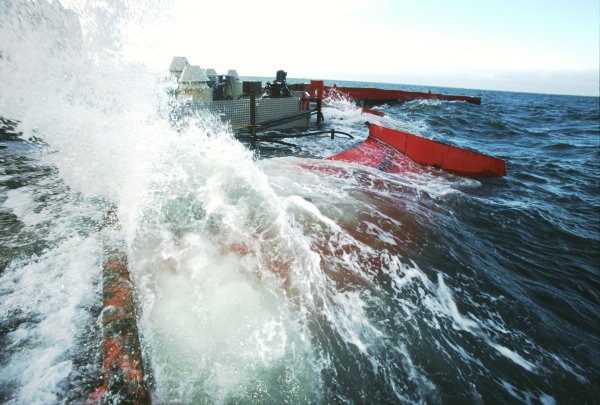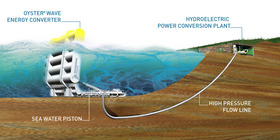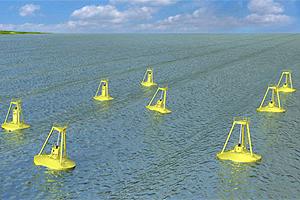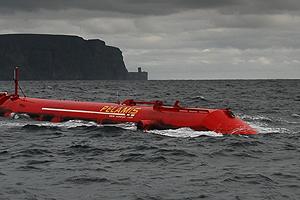Crown Estate hails UK’s 31 marine energy projects
Marine energy pipeline beefed up as eight new projects granted lease agreements
13 Oct 2011
The Crown Estate has confirmed there are now 31 wave and tidal energy projects planned for UK waters, after the agency yesterday announced that eight new projects had been granted conditional agreements, giving them access to the seabed.
As expected, Marine Current Turbines (MCT) was granted a lease agreement for its planned 10MW Skerries tidal array off the coast of Anglesey, while wave energy firm Pelamis received the same approval for its 10MW wave farm off the west coast of Lewis, near the Island of Bernera.
In addition, AWS Ocean Energy Limited was granted a lease agreement for its Moray Firth wave farm, while similar approval was issued to four Scottish tidal energy projects proposed by Marine Energy, Nautricity, Nova Innovation and Oceanflow Development.
The latest round of lease agreements was completed by Minesto UK's plans for a tidal energy project at Strangford Lough in Northern Ireland.
The Crown Estate said that in total the latest agreements take the number
of UK marine energy projects in the pipeline to 31, potentially adding a
further 30MW of capacity.
The new projects are at a range of different development stages, with Pelamis and MCT's plans for large-scale demonstration arrays contrasted with a number of small-scale pilot projects.
Each of the projects will now have to survey the proposed sites, undertake environmental impact assessments, and obtain statutory consent from regulators before then finalising the full sea bed lease with the Crown Estate.
Rob Hastings, director of the marine estate at the Crown Estate, said the organisation is continuing to see "strong interest" in wave and tidal leases. "The Crown Estate's growing wave and tidal team looks forward to working with the companies to overcome development barriers and see the projects come to fruition," he added.
Scottish government energy minister Fergus Ewing hailed the latest awards as further evidence of the country's position as the world's leading marine energy market. "Scotland has the potential to lead the world in wave and tidal energy, with a quarter of Europe's tidal stream and a tenth of its wave energy potential," he said. "These new projects around the north and west of Scotland bring the total number of planned developments in Scotland to 25, including 1.6GW in the Pentland Firth and Orkney waters strategic area."
OPT's wave power device withstands Hurricane Irene
14 September 2011
Ocean Power Technologies Inc (OPT) says its PowerBuoy wave power device, which was recently deployed off the coast of New Jersey, successfully withstood the severe conditions during Hurricane Irene.
By Kari Williamson
The wave power device, which was deployed under the US Navy's Littoral Expeditionary Autonomous PowerBuoy (LEAP) programme, was in the direct path of Hurricane Irene, which hit the New Jersey coastline at the end of August.
The PowerBuoy emerged from the two-day storm undamaged and fully operational, with all the buoy's systems having withstood wave heights of up to 15 m (nearly 50 ft), OPT says.
During the storm, the wave power device continued to supply consistent power to its communications and radar payload, and dissipate the high amounts of surplus energy it produced.
Furthermore, nearly constant communication was maintained with the wave power device throughout the storm, allowing continuous on-land monitoring of the buoy's status and performance.
The PowerBuoy operated on a fully autonomous basis, implementing the requisite power management and system protection functions without the need for any human intervention, OPT says.
Charles F. Dunleavy, CEO of OPT, comments: "We are pleased to report the outstanding performance of our PowerBuoy off the coast of New Jersey during Hurricane Irene's onslaught. Despite encountering significant wave heights, the buoy continued to produce power and operated exactly as designed for extreme sea conditions. On Monday morning, after the storm passed, our PowerBuoy was right on station where it had originally been deployed and was operating to the Navy's specifications as it did prior to the storm.
“This achievement stands as an important testament to the skills and innovation of our engineering and operations teams. Following the successful operation of our utility PowerBuoy at the Marine Corps Base in Hawaii during the tsunami-driven waves caused by the earthquake in Japan earlier in 2011, the performance of this LEAP buoy further demonstrates the reliability of OPT's core PowerBuoy products and the viability of wave power as an alternative source of energy."
The PowerBuoy wave power device continues to undergo sea trials approximately 20 miles off the coast of New Jersey under a US Navy programme for coastal security and maritime surveillance.
The LEAP PowerBuoy structure, incorporating a power take-off and on-board energy storage system, is significantly smaller and more compact than OPT's standard utility PowerBuoy. It is designed to provide persistent, off-grid, clean energy in remote ocean locations for a wide variety of maritime security and monitoring applications.



